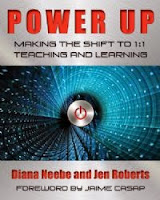Here are some of my favorite books and some new ones that I am looking forward reading when they are released this summer. These books don't just describe using the technology, but also give great ideas and examples on how to use it in your class, in all disciplines.
- Blended Learning -Leveraging the Power of Technology to Create Student-Centered Classrooms by Catlin Tucker
- Catlin was our keynote speaker in August, and this is her first book. I use this as a reference when meeting with teachers in different subject areas. It has great examples for all core subject areas, which can also be modified to work with any other subject area.

- Creatively Teach the Common Core with Technology by Catlin Tucker
- This is Catlin's new book which will be released at the end of June. I'm super excited, and have been waiting for it for a few years now. It has ideas and lesson plans to help teachers teach the CCSS literacy standards in all subject areas. Here's a description from Amazon: "As you explore the creative road to academic success, with the Common Core ELA and literacy standards—you will turn your classroom into a student-centered learning environment that fosters collaboration, individualizes instruction, and cultivates technological literacy."

- 50 Things You Can Do With Google Classroom by Alice Keeler and Libbi Miller
- Google Classroom was released this past fall and has been adopted by many teachers here in our district. It solves the problem of students having to share their Google Docs with their teachers and causing a big mess in your Shared With Me folder. Classroom helps organize both you and your students assignments using Google Apps. Alice is one of my favorite people to see at conferences and always has innovative ideas to save a teacher time. The book was just released and I am looking forward to reading it.

- Power Up: Making the Shift to 1:1 Teaching and Learning by Diana Neebe and Jen Robert's
- I have met Jen at multiple conferences and she has some amazing ideas. Her new book is geared towards high school teachers using devices with their students. Whether you have your own set of devices in your classroom, or just a cart to check out when you can, this will be a great book to help give you ideas on what to do when you have the devices. The book will be released at the end of June.

I hope you have a great summer!


